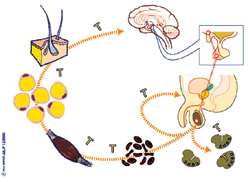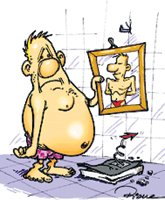
| Men Have Menopause Too The existence of andropause is one of the ongoing debates in the medical field today. Is Testosterone the panacea to all the problems of an ageing man? As websites and companies selling testosterone gloat about the benefits of testosterone it is important for readers to be informed about the matter and to come to an informed decision.
Testosterone is a hormone that has a unique effect on a man's total body. Testosterone is produced in the testes and in the adrenal glands. It is to males what estrogen is to females. Male aging is associated with a decline in blood levels of androgens (male hormone) particularly testosterone. Testosterone declines by about 0.5% to 1.6% per year in a male from the late thirties. Overall there is a 20-40% decline across life. The impact of decreasing androgens is known as andropause, also called "male menopause" or PADAM - Partial Androgen Deficiency in the Ageing Male. It is a normal part of ageing, although, for some men it is accompanied by a gradual and undesired decline in their sexuality, mood and overall energy. It is important to recognize however, that many older men maintain levels comparable to those of healthy young men. Factors other than age may be important determinants of testosterone status, including other illnesses, medications, alcohol consumption. In fact many men over 40 years of age (74%) have one of the above conditions. Although some evidence from research is available, it is important to stress that no international consensus on the benefit of treatment with testosterone has been reached yet. More proof from solid research will be required before every man with low testosterone could be treated. What is Andropause? Unlike menopause, which generally occurs in women during their mid-forties to mid-fifties, men's "transition" may be much more gradual and expand over many decades. Men do not have a clear-cut signpost such as the cessation of menstruation to mark the decline in testosterone. Both, however, are distinguished by a drop in hormone levels. Estrogen in the female, testosterone in the male. The bodily changes occur gradually in men and may be accompanied by changes in attitudes and moods, fatigue, a loss of energy, sex drive and physical agility.
Although with age, a decline in testosterone levels will occur in virtually all men, there is no way of predicting who will experience andropausal symptoms of sufficient severity to seek medical help. Neither is it predictable at what age symptoms will occur in a particular individual. Each man's symptoms may also be different. Is this a new phenomenon? Yes and no. In fact, andropause was first described in medical literature in the 1940's. So it's not really new. Now that men are living longer, there is heightened interest in andropause. Sensitive tests for bioavailable testosterone weren't available until recently, so andropause has gone through a long period where it was underdiagnosed. Another reason why andropause has been unrecognized over the years is that symptoms can be vague and can vary a lot among individuals. Some men find it difficult to admit that there's even a problem. Many questionnaires have been devised but none reliable enough to be used to define or identify men who are likely to have low testosterone. Causes Starting at about the age of 30, testosterone levels drop by about 10 percent every decade. At the same time, another factor in the body called Sex Binding Hormone Globulin, or SHBG, increases. SHBG traps much of the testosterone that is still circulating and makes it unavailable to exert its effects in the body's tissues. What's left over does the beneficial work and is known as "bioavailable" testosterone.
Andropause is associated with low (bioavailable) testosterone levels. Every man experiences a decline of bioavailable testosterone but some men's levels dip lower than others. And when this happens these men can experience andropausal symptoms. These symptoms can impact their quality of life and may expose them to other, longer-term risks of low-testosterone. It is estimated that 8 to 20 percent of men in their 60s will have testosterone levels low enough to be causing symptoms. Importance of Testosterone Testosterone helps to build protein and is essential for normal sexual behavior and producing erections. It also affects many metabolic activities such as production of blood cells in the bone marrow, bone formation, lipid metabolism, carbohydrate metabolism, liver function and prostate gland growth. Impact of low Testosterone When there is less testosterone available to do its work, the testosterone target-organ response decreases, bringing about many changes.
There is great variability in testosterone levels among healthy men so not all will experience the same changes to the same extent. But typical responses to low bioavailable testosterone levels include:
Association between low testosterone and changes of ageing There are similarities between the features of low testosterone and aspects of 'normal' ageing. However this does not establish causality and further research will be needed before this can be established beyond doubt. Body composition Between 25 and 70 years there is on average, a 12 kg loss of muscles and similar increase in fat in men. The loss of muscle correlates with loss of bodily strength. This seems to be a result of loss of testosterone. Osteoporosis In a healthy individual, bone tissue is constantly being broken down and rebuilt. In an individual with osteoporosis, more bone tissue is lost than is regenerated. We've all heard of women suffering from weaker bones or osteoporosis, after menopause. In men, testosterone is thought to play a role in helping to maintain this balance. Between the ages of 40 and 70 years, male bone density falls by up to 15 percent. Low bone density puts one at risk of frequent fractures, associated pain, and in many cases, loss of independence. Wrists, hips, spine and ribs are most commonly affected. Two important consequences of osteoporosis are often seen as a slow but progressive rounding of the shoulders as well as a loss of height and back pain. Particularly devastating seem to be hip fractures, up to one third of patients never seem to regain full mobility. Cardiovascular risk It is now well accepted that women's risk of atherosclerosis (hardening of the arteries) increases after menopause, although, estrogen replacement therapy does not seem to reverse this trend (unlike earlier belief). Some research suggests that a similar phenomenon occurs in men as their testosterone levels diminish with age. While research is not as complete as for women, the clinical findings point to an association between low-testosterone levels and an increase in cardiovascular risk factors in men. A cause and effect relationship has not yet been established in large clinical trials. Further clinical research is needed into this important area of study. Benefits of Testosterone treatment in men with andropause It is important to realize that there is no definite research data in this area. However a few studies are available and the following seem to be benefits of the treatment. Body composition A decrease in body fat and increase in body composition of muscles has been reported. However an improvement in body strength has not been shown. Bone Testosterone improves bone density but the golden yard stick - reduction in fractures has not been shown Sexual function Improvement in sexual motivation and performance were noted in individuals whose testosterone levels were definitively low. No improvement was seen in others. However, the erectile function was not better with testosterone. Erectile failure in this age is usually due to other problems such as poor circulation and will need appropriate evaluation and treatment Overall well being Here the data is not very encouraging. Despite what has been believed the treatment with testosterone did not improve well being or depression. Potential risks of Testosterone It must be remembered that testosterone can cause potential harm. These are increase in prostate size, change in cholesterol levels and increase in sleep apnoea in those who have it. The testosterone tablets which are commonly abused can damage liver and are not recommended. In summary, there are potential benefits of treatment of andropause for those who have definitely low levels of testosterone. (The writer is a Consultant Endocrinologist at the National Hospital) |
|| Front
Page | News | Editorial | Columns | Sports | Plus | Financial
Times | International | Mirror | TV
Times | Funday
Times | MediScene || |
| |
Copyright
2007 Wijeya
Newspapers Ltd.Colombo. Sri Lanka. |



